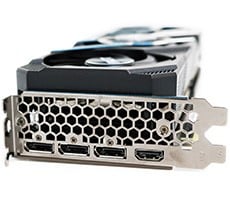3DMark05 & Halo v1.06
|
| 3DMark05 is the latest installment in a line of synthetic 3D graphics benchmarks, dating back to late 1998. 3DMark99 came out in October 1998 and was followed by the DirectX 7 benchmark; 3DMark2000, which was released roughly two years later. The DirectX 8.1-compliant 3DMark2001 was released shortly thereafter and became a very popular tool used by many hardcore gamers. 3DMark03, however, wasn't quite as well received thanks in no small part to the disapproval of graphics giant NVIDIA. With 3DMark05, though, Futuremark hopes to regain some of its audience with a versatile and advanced DirectX 9 benchmarking tool. We ran 3DMark05's default test (1,024 x 768) on all of the cards and configurations we tested, and have the overall results for you posted below. |

Thanks to its higher fillrate and superior compute performance, the GeForce 7800 GTX was between 20% and 52% faster than any other single-card configuration. Only a pair of GeForce 6800 Ultras was able to outgun the 7800 GTX in 3DMark05's default test. With a pair of GeForce 7800 GTX cars running in SLI mode, however, nothing even came close. The 7800 GTX SLI configuration was between 16% and 128% faster than any other setup we tested.
|
| No additional patches or tweaks are necessary to benchmark with Halo, as Gearbox has included all of the necessary information to test with this game within its Readme file. Basically, all that you have to do is install the game and modify its shortcut to set the resolution, refresh rate, and rendering mode. Then the benchmark works by running through four of the long cut-scenes from the game, after which the average frame rate is recorded. We patched Halo using the most recent v1.06 patch and ran this benchmark twice, once at a resolution of 1,280 x 1,024 and then again at 1,600 x 1,200. Anti-aliasing doesn't work properly with Halo, so all of the tests below were run with anti-aliasing disabled. |


In the past, we've typically tested video cards at resolutions of 1,024 x 768 and 1,600 x 1,200. For this article, though, we tested all of the cards at 1,280 x 1,024 and 1,600 x 1,200 - eliminating the 1,024 x 768 tests. Even today's mid-level graphics cards are capable of running most games at 1024x768, so the high-end powerhouses tested here would have no trouble with this relatively low resolution. Testing at a minimum resolution of 1,280 x 1,024 should also help alleviate the CPU bottleneck in some tests, which will give us (and you) a better idea of how a particular video card performs.
Although Halo may no longer have "cutting-edge" graphics by today's standards, the game is still GPU limited in most circumstances, as is evident by the graphs above. In these tests, the new GeForce 780 GTX outperformed all of the single card configurations by 22% - 43% at 1,280 x 1,024 and even nudged past the 6800 Ultra SLI configuration by a few percentage points. With the resolution cranked up to 1,600 x 1,200, the single 7800 GTX essentially performed at the same level as the 6800 Ultra SLI rig and smoked the other cards by at least 30%. The GeForce 7800 GTX SLI configuration simply tore through Halo, only dropping 4 FPS after raising the resolution from 1,280 x 1,024 to 1,600 x 1,200.








